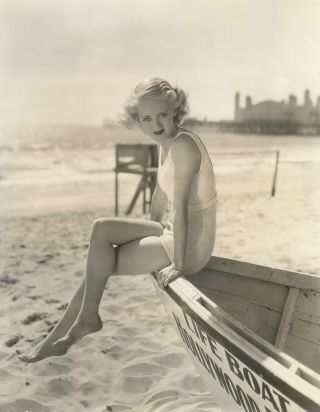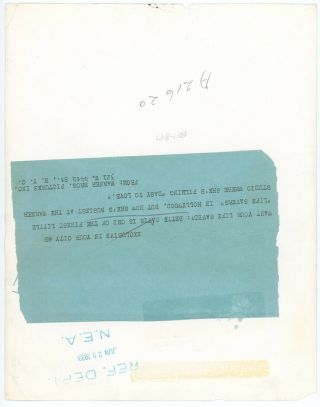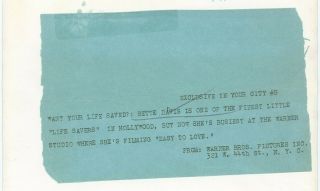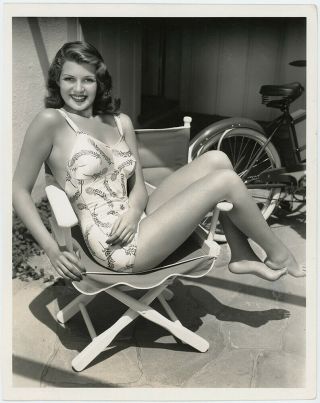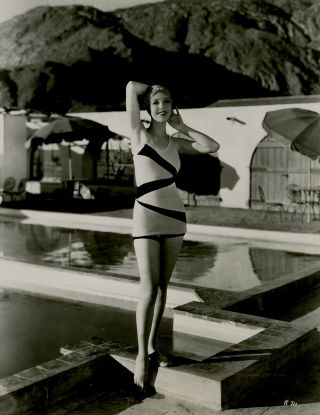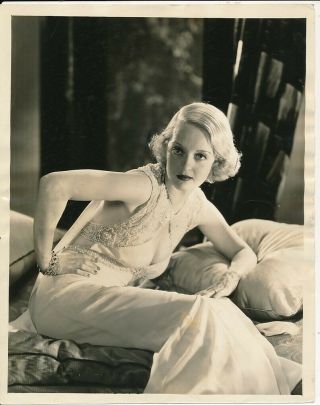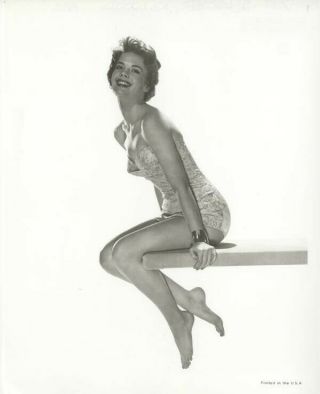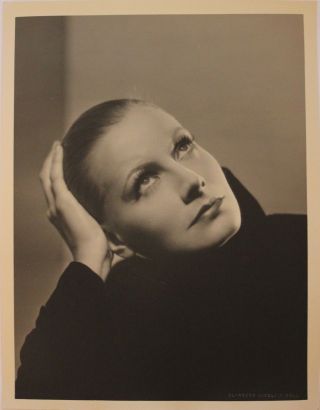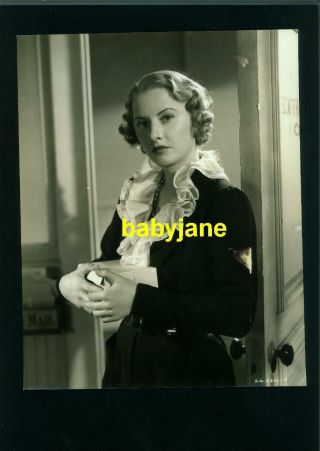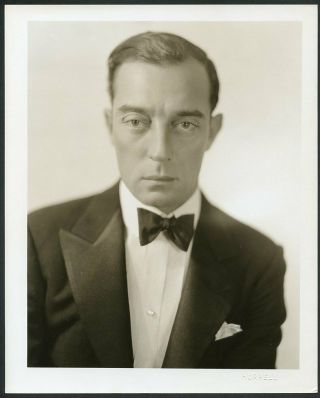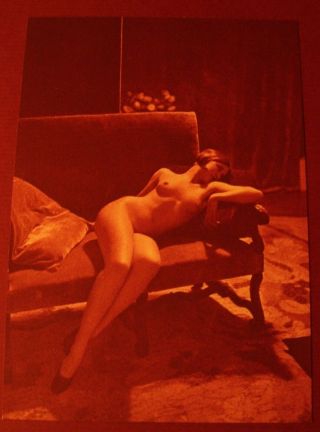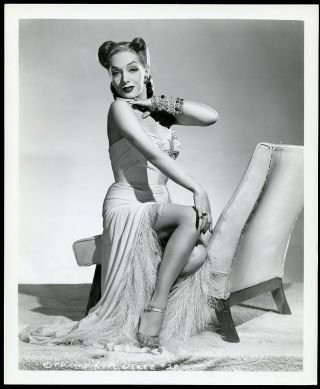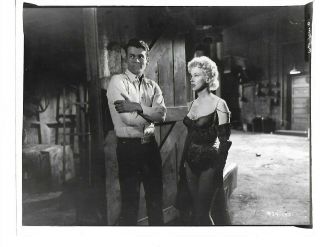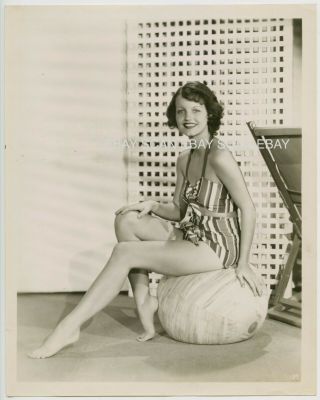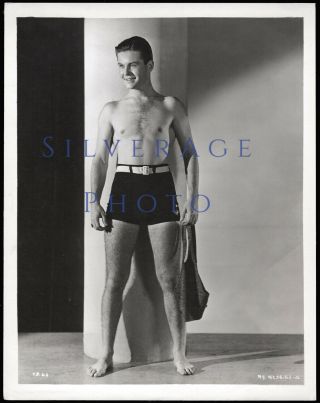Pretty Barefoot Bathing Beauty Bette Davis Vintage 1933 Breezy Pin - Up Photograph
Item History & Price
WAN...T YOUR LIFE SAVED?: BETTE DAVIS IS ONE OF THE FINEST LITTLE "LIFE SAVERS" IN HOLLYWOOD, BUT NOW SHE'S BUSIEST AT THE WARNER STUDIO WHERE SHE'S FILMING "EASY TO LOVE."
Regarded as one of the greatest actresses in Hollywood history, Bette Davis got her start appearing in Broadway plays before moving to Hollywood in 1930. Her early films for Universal were largely unsuccessful but she found longtime success and critical acclaim after signing with Warner Brothers. Until the late 1940s, she was one of American cinema's most celebrated leading ladies, known for her forceful and intense style as well as her willingness to play unsympathetic, sardonic characters and her capability in a range of film genres.
Photograph measures 8" x 10" on a glossy single weight paper stock with studio paper caption, REF. DEPT. ink stamp, and handwritten notations on verso.
Guaranteed to be 100% vintage and original from Grapefruit Moon Gallery.
More about Bette Davis:
A strong-willed, independent woman with heavy-cast eyes, clipped New England diction, and distinctive mannerisms, Bette Davis left an indelible - and often parodied - mark on cinema history as being one of Hollywood's most important and decorated actresses. Over the course of her storied career, Davis made some 100 films, for which she received 10 Academy Award nominations, and twice won the Best Actress trophy. But her sometimes over-the-top affectations - which no doubt made her a gay subculture icon - hindered her career despite the enormity of her talents. Not a glamorous star, Davis went through a string of forgettable pictures before tackling the rather unsympathetic Mildred in "Of Human Bondage" (1934), which turned her into a star and earned the actress her first Oscar nomination. She won the Academy Award the following year for "Dangerous" (1935) and later earned her second statue for one of her most famous performances in "Jezebel" (1938). By this time, Davis was a big star and went on to a series of box office hits like "Dark Victory" (1939) and "Now, Voyager" (1942). But after the personal tragedy of losing her husband, Arthur Farnsworth, Davis went into serious professional decline, only to resurrect herself with a delectably over-the-top performance in "All About Eve" (1950). Her resurgence was brief, however, as Davis once again was forced to accept a number of mediocre films while going through a number of personal travails. After emerging one last time with her Oscar-nominated turn in "Whatever Happened to Baby Jane?" (1962), Davis settled into a succession of film and television roles that culminated with her last acclaimed performance in "The Whales of August" (1987). Passing just two years later, Davis was remembered as one of Hollywood's greatest actresses, a legacy forged by an iron will to go her own way.Born on April 5, 1908 in Lowell, MA, Davis was raised by her father, Harlow, a patent attorney, and her mother, Ruth; her parents later separated in 1915. Going to live with her mother, Davis was later encouraged to try her hand at acting after the family moved to New York City. After attending the Cushing Academy, a private boarding school in Massachusetts, she trained at the Mariarden School of Dancing and John Murray Anderson's Drama School in New York. Rejected for Eva Le Gallienne's acting classes, Davis instead joined a stock company in Rochester, NY that was run by George Cukor. Initially unimpressed with the actress, Cukor gave her a chance nonetheless, though he wound up dismissing Davis after only a few months. Meanwhile, she made her New York acting debut in 1928 at the Provincetown Playhouse in Virgil Geddes's "The Earth Between, " which received excellent reviews and led to parts in other successes, including her first Broadway hit, "Broken Dishes" (1929), at the age of 21. Davis went on to star in "Solid South, " where a talent scout for Universal Studios saw her performance and invited her to Hollywood for a screen test.In 1930, Universal Pictures signed Davis to a contract and she made her film debut in "Bad Sister" (1931), which also featured Humphrey Bogart. Appearances in five more lackluster films discouraged the young actress until actor George Arliss, who went on to remain her mentor, persuaded Warner Bros. to hire Davis to play opposite him in "The Man Who Played God" (1932). The prestigious drama proved to be her breakthrough film and led to Warner Bros. signing the actress to a long-term contract, thus beginning her stormy relationship with a studio more accustomed to promoting its tough male stars. Over the next three years, Davis made 14 films for Warner Bros., some of them forgettable. But her career took a dramatic turn when she was lent to RKO to play the slatternly Mildred opposite Leslie Howard in "Of Human Bondage" (1934), an unsympathetic role that several other actresses had turned down. The role gave Davis an opportunity to cut loose, with her riveting performance garnering her first substantial critical acclaim. With Warner Bros. now taking notice of her, Davis began to get better parts, including "Dangerous" (1935), for which she won her first Oscar.The following year, Davis reunited with Howard and Bogart for "The Petrified Forest" (1936), a crime drama in which she played a small town waitress with dreams of living abroad, only to find her hopes dashed by a desperate gangster. That same year, Davis' long-standing resentment against the strictures of the studio contract system - not to mention the string of mediocre roles - came to a head when she defied Warner Bros. and went to London to make two pictures with a British company. Warner Bros. sued her for breach of contract, while Davis fled to Canada to avoid being served. But she soon brought her case to the British courts, where she was portrayed in the media as being spoiled and overpaid. Despite her repeated attempts to state that she was fighting for better roles, Davis ultimately lost her case and returned to Hollywood, where she was surprisingly treated with newfound respect; Warner Bros. signed her to a new contract and offered her even better roles. In fact, Davis embarked on the peak period of her career with a series of memorable roles, starting started with her fiery turn as a Southern belle in "Jezebel" (1938), for which she won her second Oscar. She also entered into a relationship with director William Wyler, whom Davis once described as the love of her life.From there, Davis went on to enormous success with Warner Bros. and had one of her biggest box office hits with "Dark Victory" (1939), which she cited as her favorite performance. Her box office success continued with "The Old Maid" (1939), "Juarez" (1939) and "The Private Lives of Elizabeth and Essex" (1939), starring Errol Flynn. As she perfected her acting techniques and developed her famous mannerisms - a clipped manner of speaking with cigarette always in hand - Davis achieved a new level of artistic maturity. Filmgoers, especially women, loved her portrayals of fiercely independent characters who suffered nobly. In the early 1940s, Davis' popularity continued to grow with such films as "All This and Heaven Too" (1940), "The Letter" (1940), and "The Little Foxes" (1941), plus her roles as a timid spinster who blossoms into a vital woman of the world in the melodramatic "Now, Voyager" (1942). With World War II raging across the globe, Davis began choosing roles that reflected the times, including "Watch on the Rhine" (1943) and the war bond fundraiser "Thank Your Lucky Stars" (1943).In August 1943, Davis suffered a personal tragedy when husband, Arthur Farnsworth, suddenly collapsed while walking on the street. An autopsy later revealed that he had a skull fracture that occurred two weeks prior, though Davis knew of nothing that might have caused the injury. Distraught, she tried to withdraw from her next picture, but nonetheless was convinced by Warner Bros. studio head Jack Warner to continue on with playing her role as a vain society woman in "Mr. Skeffington" (1944). Her erratic behavior onset may have been due to her losing Farnsworth, and ultimately led to a precipitous career slide. She turned down the lead in "Mildred Pierce" (1945) to accept the role of a schoolteacher determined to educate a Welsh mining town in "The Corn is Green" (1945). The film was well-received and a box office hit, though her soon-to-be nemesis Joan Crawford's electrifying turn in "Mildred Pierce" won her the Best Actress Oscar. Meanwhile, Davis followed with the lackluster drama, "A Stolen Life" (1946), while the film noir "Deception" (1946), was her first picture during this period to lose money.Though set to star in "Possessed" (1947), Davis took time off to have daughter, Barbara Davis Sherry, and briefly flirted with the idea of leaving show business to focus on being a mother. She went on to star in the confusing adaptation of Ethel Vance's novel, "Winter Meeting" (1948), before clashing with co-star Robert Montgomery on "June Bride" (1948). Despite hating the script for "Beyond the Forest" (1949), Davis was forced by Jack Warner to play the neglected wife of a small town doctor who engages in adultery and extortion. Critics were scathing in their reviews and Davis succeeded in getting Warner to release her from her contract. Though sagging under the weight of weak pictures, Davis soon bounced back with a stunning performance as Margo Channing, a tempestuous, gin-swilling Broadway star - reportedly based on Tallulah Bankhead - in Joseph Mankiewicz's "All About Eve" (1950). The film's wittily savage view of theater people offered Davis the role of a lifetime. With her almost self-parodying grand gestures and now-famous line, "Fasten your seat belts, it's going to be a bumpy night, " Davis' performance earned her an Academy Award nomination for Best Actress and went on to become one of her most iconic roles.Regardless of this brief encounter with critical and box office success, Davis' career began to seriously falter in the 1950s with failures like "Another Man's Poison" (1951). Her Oscar-nominated turn in "The Star" (1952) failed to put the brakes on her downward slide, which accelerated with an uncomfortable Broadway performance in the musical "Two's Company" (1952). Meanwhile, her personal life deteriorated alongside her career after divorcing William Sherry and marrying Gary Merrill, with whom she had an abusive relationship fueled by alcohol. Davis hit a career low with "The Virgin Queen" (1955), "Storm Center" (1956) and "The Catered Affair" (1956), while also eventually divorcing Merrill in 1960. Following a poorly reviewed Broadway production of "The Night of the Iguana" (1961) and the rather mediocre Frank Capra comedy "Pocketful of Miracles' (1961), Davis came roaring back again with a tour-de-force performance in "Whatever Happened to Baby Jane?" (1962) in which she and Joan Crawford squared off as a pair of nutty sisters, both showbiz has-beens living in a decaying Hollywood mansion. Both Davis and Crawford famously despised each other during filming, but waited for the shooting to end to engage in a public war of words. Meanwhile, Davis earned another Academy Award nomination for Best Actress - the last of her career.With "Baby Jane, " new life was breathed into Davis' career and she enjoyed a decade-long revival with acclaimed turns in the crime drama "Dead Ringer" (1964), the romantic drama "Where Love Has Gone" (1964) and "Hush Hush, Sweet Charlotte" (1964), which went on to become a considerable box office success. She closed out the decade with a trio of British-made films, "The Nanny" (1965), "The Anniversary" (1968) and "Connecting Rooms" (1970). Davis next starred opposite Ernest Borgnine as a senior citizen couple who disguise themselves as hippies and embark on a series of crimes in "Bunny O'Hare" (1971). Finding further life on the small screen, she starred in "The Judge and Jake Wyler" (NBC, 1972) and "Madame Sin" (1972), while accepting roles in the horror movie "Burnt Offerings" (1976) and the Disney sequel "Return to Witch Mountain" (1978). In between those two pictures, Davis became the first woman to receive the American Film Institute Life Achievement Award, an honor bestowed upon her in 1977. She was part of a large ensemble cast that included Peter Ustinov, Maggie Smith, David Niven and Mia Farrow in "Death on the Nile" (1978), based on the Agatha Christie novel, while appearing in small screen miniseries and movies like "The Dark Secret of Harvest Home" (NBC, 1978), "Strangers: The Story of a Mother and Daughter" (CBS, 1979), with Gena Rowlands, and "White Moma" (CBS, 1980), opposite Jackie Cooper and Anne Ramsey.A survivor of four unhappy marriages and estrangement from her daughter, Davis found her greatest satisfaction in working and continued to do so until the end. She co-starred in the British horror movie, "The Watcher in the Woods" (1980), while making more frequent appearances on TV with "Family Reunion" (NBC, 1981), "A Piano for Mrs. Cimino" (CBS, 1982) and "Little Gloria Happy at Last" (NBC, 1982). Davis starred opposite James Stewart in the small screen drama "Right of Way" (NBC, 1983) before turning back to Agatha Christie for "Murder with Mirrors" (CBS, 1985). With her health in serious decline since being diagnosed with breast cancer and receiving a mastectomy in 1983, Davis nonetheless continued to perform. She had a series of strokes that left her with slurred speech and partial paralysis, though her daughter's betrayal in writing about their troubled relationship in her memoir, My Mother's Keeper (1985), proved far more debilitating to Davis, who was forced to endure her own Mommie Dearest expose, unlike her late nemesis, Joan Crawford, who was thankfully deceased at the time her daughter Christian penned her own poison pen memoir. Davis went onto to make her final significant film appearance in "The Whales of August" (1987) opposite Lillian Gish. Despite strong performances from both, neither received the awards recognition many expected. Meanwhile, her cancer returned during a period where she was receiving a number of lifetime awards. She managed to travel to Europe, but became too weak and was hospitalized in France, where she died on Oct. 6, 1989. She was 81 and left behind a legacy as one of Hollywood's greatest and most ferociously independent actresses.
Biography From: TCM | Turner Classic Movies




